Laurenzio Laurenzi
LAURENZIO LAURENZI
Laurenzi (1878-1946) dedicated three exclusive works to Villa Barluzzi in which his distinctive features emerge: the naturalism of the composition and the attention to the rendering of light. The reproduction of the entire villa is extremely refined, allowing us to admire every smallest detail, while the landscape view of Villa Rufolo from Villa Barluzzi created at Christmas 1933 and the detail of the façade of the structure offer a precious historical memory of places and people of the time.The Umbrian painter and engraver who moved to Rome had traveled extensively between European capitals, African colonies and the Middle East, in particular when he was commissioned to create a series of 80 etchings, reproducing monuments of the imperial age of various Mediterranean countries. In his artistic career he initially dealt mainly with landscapes, with views and scenes characterized by a realist tendency, while from the 1920s onwards he dedicated himself to colonial painting with subjects inspired by his travels and African portraits. He too, like Barluzzi, was a member of the Accademia dei Virtuosi at the Pantheon in Rome.
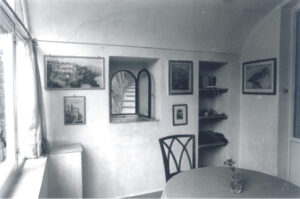
Interiors of Villa Barluzzi with original works by Laurenzio Laurenzi photographed by Domenico De Masi
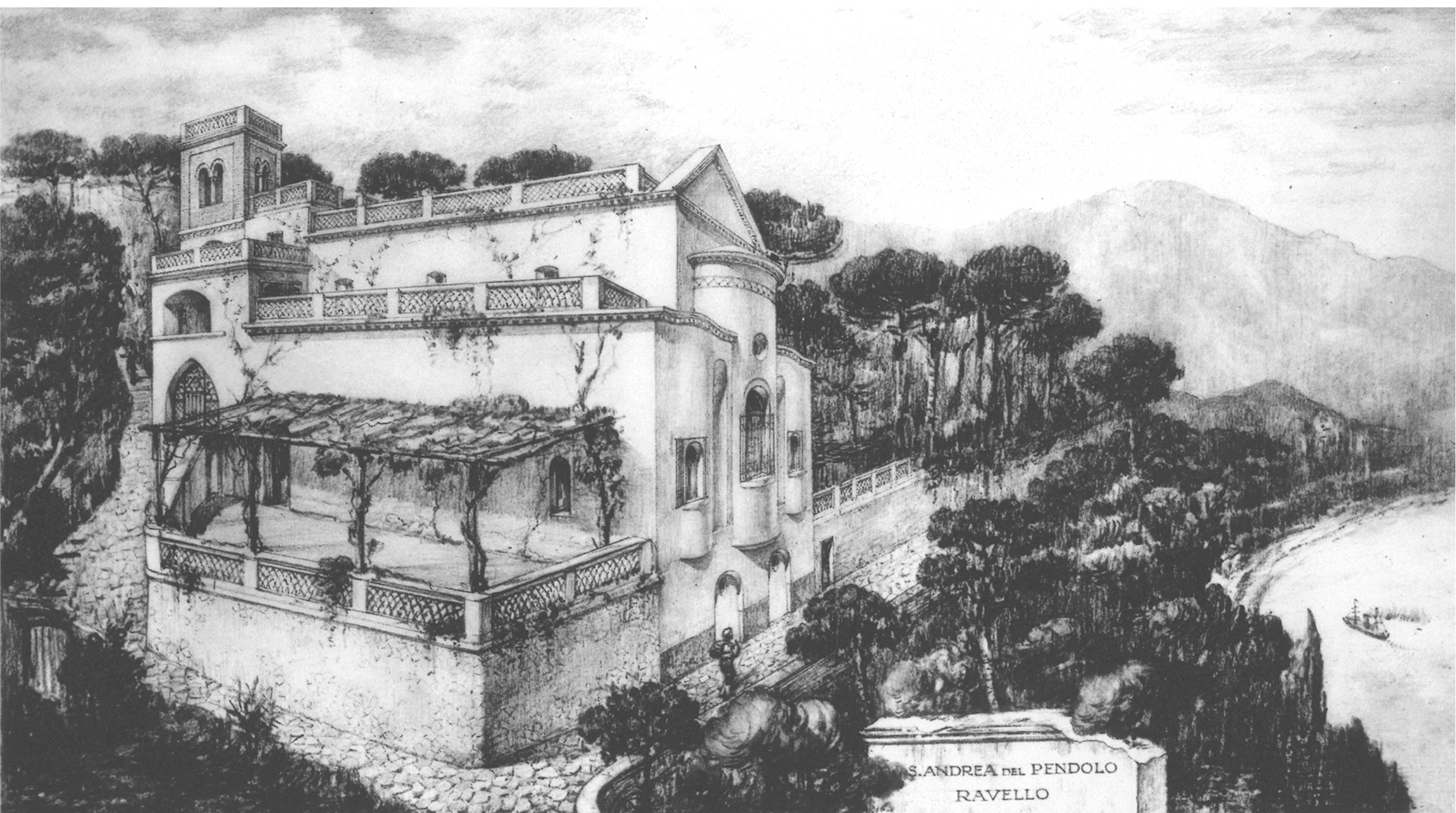
Villa Barluzzi
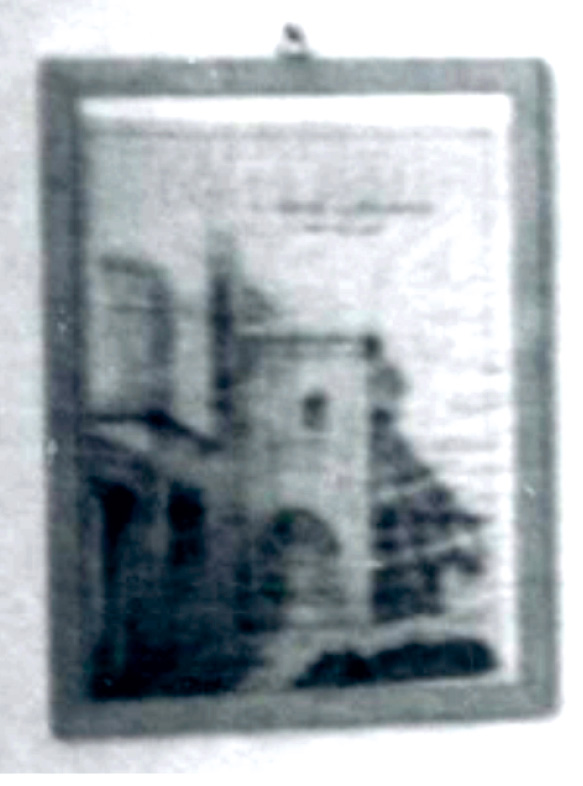
Villa Barluzzi
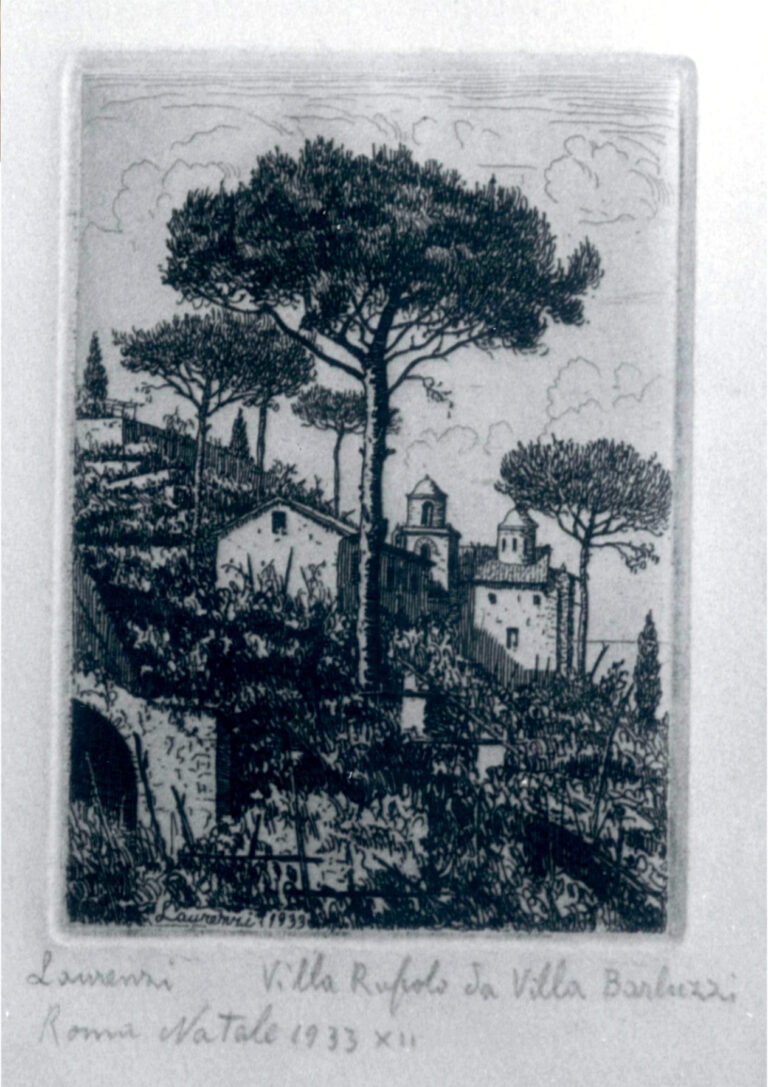
Laurenzi – Villa Rufolo from Villa Barluzzi.
Rome, Christmas 1933
Other works by Laurenzio Laurenzi dedicated to landscapes in Campania:
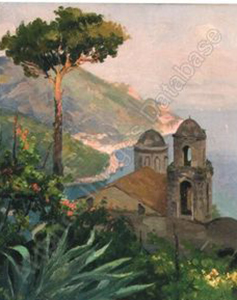
Ravello
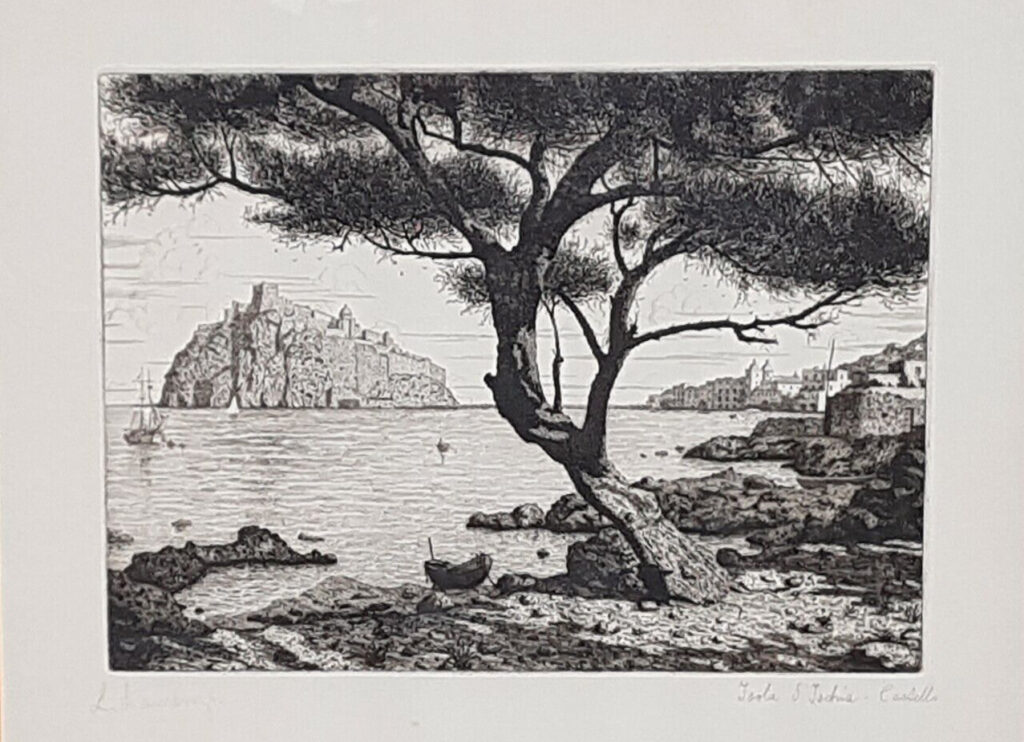
Ischia
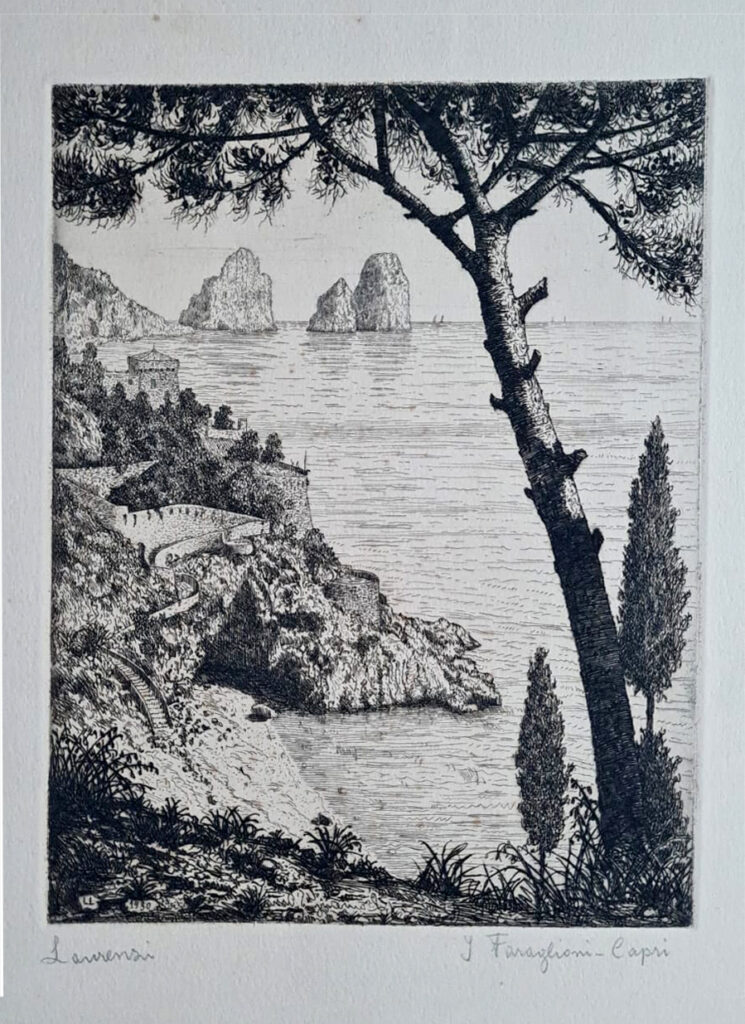
Capri
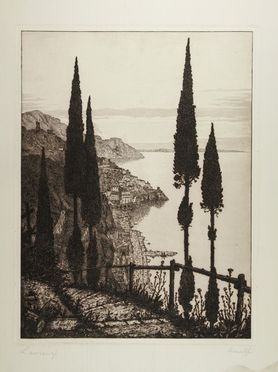
Amalfi
Laurenzio Laurenzi in Ravello
At the end of the 1920s, the National Fascist Party, continuing its work of sports propaganda, which had begun with the aim of providing physical education for Italian youth, decided to gradually build a sports field in all the municipalities of Italy which, while responding to the modern needs of sport, was easy and inexpensive to implement in practice.
In the census work launched to verify which municipal entities lacked facilities, the Sports Office of the National Party Directory, with communication dated 17 December 1929, noted that the territory of the Municipality of Ravello had not yet proceeded with the creation of a sports field.
Thus, on 4 October 1930, at the Municipal House (then located in the convent complex of San Francesco), the Prefectural Commissioner of Ravello, Umberto Nisi, who at the same time was also President of the Autonomous Company, on the sidelines of a meeting with the Political Secretary of the Fascio Alfonso Mansi, the Secretary of the female fascist Maria Mansi, the centurion of the Volunteer Militia for National Security Pasquale Armenante, notables and hotel entrepreneurs, in the presence of the journalist Tommaso De Vivo, opened a subscription which, including the contribution of the Municipality and the Autonomous Company, had quickly reached the sum of almost 12,000 lire.
Among the first bidders are the artist Laurenzio Laurenzi of Rome, the baron Giuseppe Compagna, who offered 1000 lire, constituting the sum deposited as a guarantee fund for the rent of the Torre dello Scarpariello, and the engineer. Giulio Barluzzi, who in 1926, after acquiring it, had restored and transformed the ancient church of Sant’Andrea del Pendolo into a private residence.
Laurenzi and the Barluzzi – Anderson family
The Domus Jucundiana, the villa of Giulio Barluzzi (1879-1953), engineer and architect, and his wife Maria Anderson, was an important meeting place for the exponents of Roman artistic and social life of the 30s and 40s of the twentieth century. The villa is located near Porta San Sebastiano in front of the tombs of the Scipios and had taken its name from the sarcophagus of a Jucumdianus that had been discovered there. In the book “Liber amicorum” you can read poems, short comments and signatures of Roman artists, cardinals and aristocrats who frequented the villa dating from 1928 to 1969, including Marinetti (26 December 1932) and Benedetta Cappa Marinetti, Giulio Aristide Sartorio, Marga Sartorio (Blessing all ‘Absent dearest, but also present today, 25-5-1930), Alessio and Tamara Issupoff, G.B Crema, Giuseppe Romagnoli, Respighi, Ceccarius, Laurenzo Laurenzi, Aurelio Mistruzzi, Rodolfo Villani, Nicolò d’Antino, Piero Scarpa, the painter and journalist Carlo Montani, the historian and art critic Piero D’Achiardi, the painter Enrico Arcioni, the historian Mario Praz. The hosts also welcomed academies of scholars who came to visit the villa or school groups. The pages are full of signatures until 1953, the year of Barluzzi’s death; only the last 3 bear signatures from the 1960s.
The painter of the colonies
Laurenzio Laurenzi (Assisi, 1878 – Rome, 1946), who moved to Rome from Assisi, attended the Academy of Fine Arts, where he studied painting and engraving. But the Umbrian artist’s real formative experience took place through the numerous journeys he made since the 1920s, between European capitals, African colonies and the Middle East.
Known above all for being a “colonial” painter, Laurenzio Laurenzi until the first post-war period and therefore in his still youthful phase, mainly dealt with landscapes dedicated to the Umbrian land.
He participated in all the exhibitions of the Roman Secession from 1913 to 1916, presenting some views and scenes, all still executed in Italy and characterized by a realist tendency and a strong attention to tonal and light effects.
It is from the 1920s onwards that Laurenzio Laurenzi dedicated himself almost exclusively to oil views and engravings born from his travels in the African colonies in Somalia, Ethiopia and Eritrea, moving to a dry and direct style, in which the plastic values of figures and architectural and naturalistic elements blend into balanced and luminous compositions.
The etchings that the Assisi artist executed to document the grandeur of colonial Italy and the monumentality of the areas under our control are very famous. From this experience was born an album of eighty recordings performed between Africa, Turkey and Greece.
Among his most famous images are those of the Castles of Gondar, built during the ancient kingdom of Fasiladas in the seventeenth century and restored by the fascist government. The grandeur of the monuments present in the views and scenes of Laurenzio Laurenzi then offer a certain symbolism of continuity with the Roman imperial conquests of Leptis Magna.
On the other hand, in the artist’s engravings and canvases there are also small and precious portraits of African women and men, interpreted with grace, expressiveness and with the intention of giving life to a real reportage.
During the 1930s and 1940s, his engravings were published several times by Italian newspapers and allowed him to exhibit not only in our country, but also abroad, between Paris, London and Prague.
In 1932, in Verona, he was among the artists who participated in the Agriculture and Horse Fair, in the “Colonial Agricultural Exhibition” section. While Mario Ridola (1890-1972) presents some views of Cyrenaica, Laurenzio Laurenzi brings his contribution with some landscapes, architecture and figures from Eritrea and Somalia.
Two years later, he exhibited at the Maschio Angioino International Colonial Art Exhibition in Naples, where he achieved considerable critical success. With the end of the regime, the artist’s activity slowed down, until, in 1946, at the age of sixty-eight, he was found dead in his Roman studio.
Laurenzio Laurenzi: from the Umbrian landscape to colonial art
Laurenzio Laurenzi’s first pictorial phase is certainly less known than the one that began in the 1920s and was entirely dedicated to the documentation in images of the Italian colonies in Africa.
After his move to Rome, the painter began to exhibit at the Mostra degli Amatori e Cultori di Belle Arti in Rome. Interior of San Francesco in Assisi appears at the In Arte Libertas exhibition in 1902, while the Cloister appears at the Amatori e Cultori exhibition in 1903.
Throughout the 1910s, he took part in the main Roman exhibitions, such as the Secession, in which he exhibited for all four editions a series of views focused on his native land or on the travel impressions collected during his Sicilian stays: Landscape – Assisi, Fair of Saint Francis of Assisi, Mattino Umbria, San Giovanni – Palermo and In vino vita.
The naturalism of the composition and the attention to the rendering of light are the main characteristics of Laurenzio Laurenzi’s first pictorial phase. Examining the painting with the Fair of San Francesco reveals a strong interest in the narration of local folk traditions, an element that will return in colonial production.
In the 1920s, he began his travels in Tunisia, Ethiopia, Eritrea and Somalia, where he engraved eighty copper plates with impressions of local life, from landscapes to figures. The vigorous views are supported by a skilful design system and by a lively and at the same time refined chromaticism, which certainly frees itself from any rigorous constraint, to better convey the story of the colonies.
His scenes have nothing more than the imaginative orientalism of the nineteenth century, but reflect a decidedly documentary trend, aimed at exalting the glories of the regime beyond national borders.
The etchings
We have a perfect example of this in the etchings dedicated to the ruins of Roman architecture, but also of the Castles built in the seventeenth and eighteenth centuries by the Negus, such as the Castles of Gondar, Gondar – The Kusquam after the fire of the Dervishes or the Sanctuary of Axum and La Axum stele. All these, in addition to being fundamental places for the history of the North African Kingdoms, were also symbols of the colonial interventions of the twenty years. For example, the stele was broken into three parts by Italian soldiers during the Ethiopian campaign of 1935. Its fragments were laboriously transported by Italian and Eritrean soldiers to the port of Massawa, arriving in Naples in 1937 and being reassembled in Rome, to be erected in front of the Ministry of the Colonies, the current FAO, to celebrate fifteen years since the March on Rome in 1922. There is also no shortage of engravings dedicated to the monuments of Syria, such as Baalbek, the Temple of Venus, Balbeek, the Temple of Bacchus and Palmyra, the Arch of Triumph. In Greece he created Athens – Arch of Ardiano and in North Africa, between Tunisia, Libya, Algeria and Egypt, he created Algeria – Arch of Caracalla, Dugga – Temple of Caelestis, Leptis Magna, Sbeitla – Tunisia, entrance to the Forum, in which the buildings, perfect in their architectural rendering, are crossed by shadows and lights of great effect. At the 1934 Colonial Art Exhibition in Naples, he exhibited an Arab Bride which summarizes all the energy of bright chromaticism and a respectful and engaging narrative of African life. A blinding brightness focuses on the bride, as well as on the other views and engravings of infinite and deep skies, which Laurenzio Laurenzi created during the 1930s and which made him famous after his timid career opening with Umbrian landscapes.
